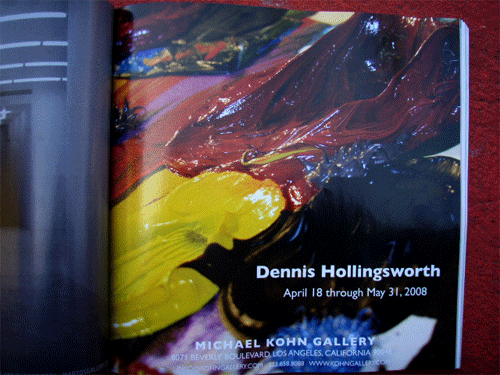April 16, 2008
A Nonpolar Art Universe

My gallery here in Los Angeles, Michael Kohn Gallery, has an ad out for our show in this month's ArtForum. Much appreciated. Interesting to see the issue focusing on the "market and its discontents", complete with a Hirst diamond skull on the cover.
Talk about telegraphing intentions.
I haven't read the issue thoroughly yet, but it is one that seems more compelling that usual and I'm eager to take its measure. Along the way I came across this article on "nonpolarity" and if you can avoid one-to-one literal conceptual alignments, it seems to be a good model with which to view our art world universe as well. Or so it seems.
Call it intuition.
At first glance, the world today may appear to be multipolar. The major powers -- China, the European Union (EU), India, Japan, Russia, and the United States -- contain just over half the world's people and account for 75 percent of global GDP and 80 percent of global defense spending. Appearances, however, can be deceiving. Today's world differs in a fundamental way from one of classic multipolarity: there are many more power centers, and quite a few of these poles are not nation-states. Indeed, one of the cardinal features of the contemporary international system is that nation-states have lost their monopoly on power and in some domains their preeminence as well. States are being challenged from above, by regional and global organizations; from below, by militias; and from the side, by a variety of nongovernmental organizations (NGOs) and corporations. Power is now found in many hands and in many places.
Here's the ArtForum Ad and a couple more clips from the Nonpolarity article:

Finally, today's nonpolar world is not simply a result of the rise of other states and organizations or of the failures and follies of U.S. policy. It is also an inevitable consequence of globalization. Globalization has increased the volume, velocity, and importance of cross-border flows of just about everything, from drugs, e-mails, greenhouse gases, manufactured goods, and people to television and radio signals, viruses (virtual and real), and weapons.Posted by Dennis at April 16, 2008 9:28 AMGlobalization reinforces nonpolarity in two fundamental ways. First, many cross-border flows take place outside the control of governments and without their knowledge. As a result, globalization dilutes the influence of the major powers. Second, these same flows often strengthen the capacities of nonstate actors, such as energy exporters (who are experiencing a dramatic increase in wealth owing to transfers from importers), terrorists (who use the Internet to recruit and train, the international banking system to move resources, and the global transport system to move people), rogue states (who can exploit black and gray markets), and Fortune 500 firms (who quickly move personnel and investments). It is increasingly apparent that being the strongest state no longer means having a near monopoly on power. It is easier than ever before for individuals and groups to accumulate and project substantial power.
Still, even if nonpolarity was inevitable, its character is not. To paraphrase the international relations theorist Hedley Bull, global politics at any point is a mixture of anarchy and society. The question is the balance and the trend. A great deal can and should be done to shape a nonpolar world. Order will not just emerge. To the contrary, left to its own devices, a nonpolar world will become messier over time. Entropy dictates that systems consisting of a large number of actors tend toward greater randomness and disorder in the absence of external intervention.
...
Leave a comment